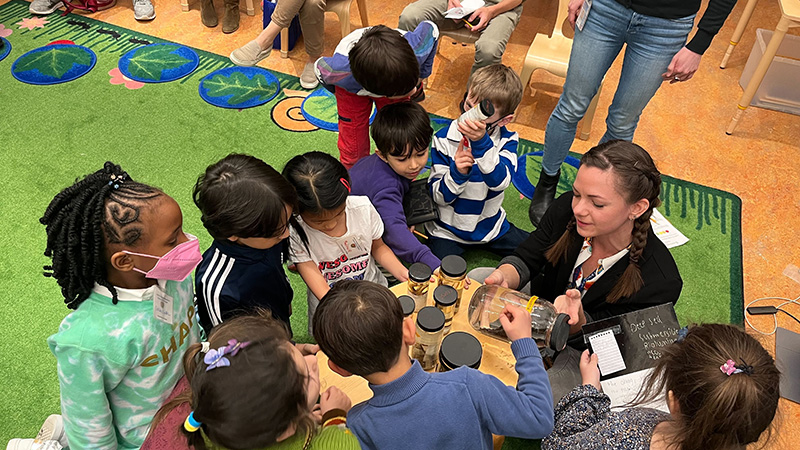Posted: 7/30/2024
Martin introducing Nebraska students to fish aglow

By Ronica Stromberg
Inarguably, the deep-sea fish that Rene Martin teaches about outshine Midwestern fish. They glow in the dark.
Called "bioluminescent" in marine biology, these fish flicker through the inky waters of the ocean like candle flames. Schools of them move like slow-motion fireworks.
Martin will give University of Nebraska-Lincoln students the chance to see specimens of such deep-sea fish up close in her "Vertebrate Zoology" class through the School of Natural Resources.
A new hire and in her first professorship, the Minnesota native came from the American Museum of Natural History in New York where she worked as a postdoctoral researcher studying deep-sea and near-shore fish. After completing a year and a half there, she received specimens as a departing gift from the museum.

"Having those specimens to show students, I'm really excited to blow their mind," she said.
Students may have seen a cartoon version of one bioluminescent fish, the anglerfish, in "Finding Nemo." Anglerfish have a light dangling over their head like a lure. When smaller fish near the glowing light, the anglerfish eats them.
Martin said such predation is only one reason deep-sea fish have glowing parts. Other fish communicate with their light organs by flashing different patterns. Many deep-sea fish cannot see red, so some fish with red light organs under their eyes flash them to view others without being seen.
One of the main reasons Martin gave for bioluminescence, though, is camouflage. She explained that fish with glowing bellies may swim at a shallower depth than their predators and a glowing belly helps them blend in with sunlight streaming down into the water. If their bellies didn’t glow, their dark body would be silhouetted by sunlight.
At the New York museum, Martin mainly worked on bioluminescent specimens collected over the past 100 years. She would dissect their light organs and section them to study their cell structure.
This research continued the studies she did on deep-sea fish, evolution and morphology (the study of the form of living organisms and the relationships between their structures) at the University of Kansas as a doctoral student and St. Cloud State University as a master’s student.
"Anytime that I'm looking at a deep-sea specimen, I'm actually finding something new,” Martin said about her research experiences. “I can very consistently publish on just new findings from these specimens because no one has really looked at them or they've been so damaged, historically, just from collection."
In the past, researchers collected deep-sea specimens by trawling, but fish became damaged tumbling in the nets. Now, researchers can use remotely operated underwater vehicles that take samples, pictures or video at great depths. These new technologies help scientists better understand behaviors and bioluminescence of deep-sea fish.
"Learning all about bioluminescence and how it has evolved in different ways is always very, very exciting to me because not a lot of people have had this opportunity,” she said. “There's just not enough scientists to look at all of these things."

She has strived to build an interest in fish, evolution and marine science by speaking at elementary schools and libraries while working at the museum and other places. She also taught as a graduate student and found she communicated science well.
She credited work as a bartender and server while paying for college up to her master's degree as giving her good communication skills.
"Working in the service industries gives you a great taste of how to better navigate social situations and to talk to people," Martin said. "I think a lot of scientists have a very hard time talking about their work in a very normal way. And so, I guarantee you the 10 years that I had as a server-bartender has significantly helped that."
She worked six years in the server-bartender role while earning an associate degree in liberal arts and sciences and then four years while earning her bachelor’s degree in ecology and field biology at St. Cloud State University.

She said she tries to be transparent and open with students about her journey to becoming a professor. She points out to them that while it took her six years to earn her associate degree, she now has her doctorate and is a professor.
She encourages students that are unsure of their path not to rush into higher education but to take internships. She interned at the Department of Natural Resources in Minnesota.
"Something I always like to mention is like, 'Take your time. Enjoy your schooling. If you fail a class, it is not the end of the world. You could pick yourself back up again,'" she said.
As a master’s student, she collected deep-sea specimens off the coast of California, and for her doctoral research, she collected near-shore specimens at Thailand. She said she would like to offer Nebraska students similar experiences.
"I plan on doing collecting trips with students for deep-sea and Midwestern fish,” she said. “That is 100 percent going to be a part of my lab and something that I push for doing because a lot of students don't have experience collecting fish, especially in a marine environment."
She said she would also like to apply for a grant to increase space on campus for a fish collection. She had worked at the Natural History Museum in Kansas while a student there and said a lot of her research has been on museum specimens.
"I have a longstanding kind of history and desire to continue to use our collection and add to our collection,” she said. “That is one of my long-term goals."
